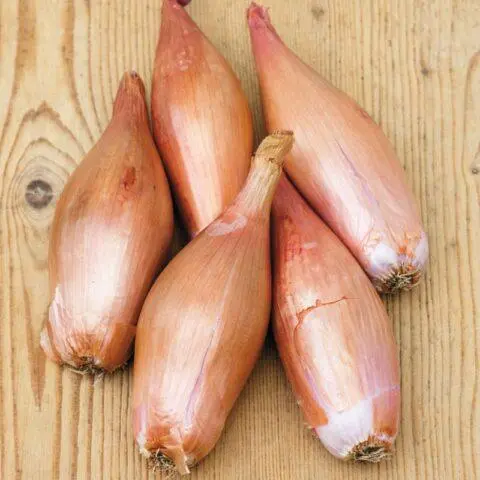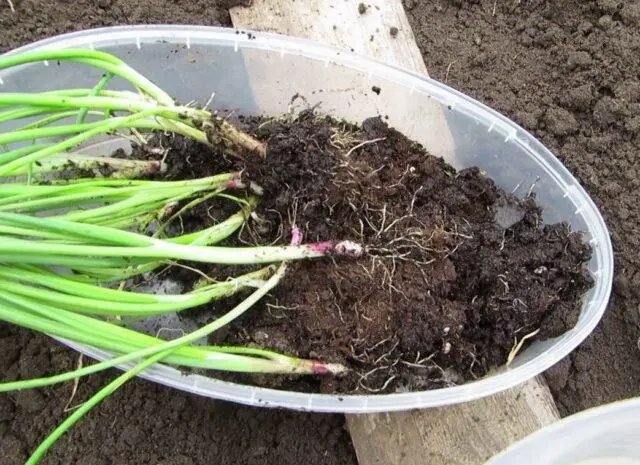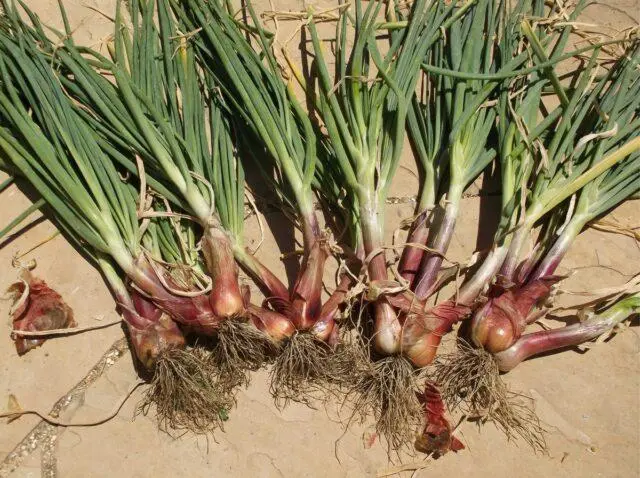Contents
Zebrun onion is an unusual shallot variety with good yields. Before planting a variety on the site, you should carefully study its features and characteristics.
History of origin
The Zebrun variety has a long history. In the 1940s, shallots were brought by refugees to the French region of Lancloitre and were grown in home gardens for about thirty years. In the 1970s, traders became interested in the variety and wanted to sell it on an industrial scale.
In 1992, shallots were officially named Poitou Chicken Leg (La Cuisse de Poulet du Poitou). In 1994, another name was proposed – Escalon (Echalion), under which the variety appeared in various catalogs in 1996. But on sale it can be found most often under the name Zebrune.
Description and characteristics of Zebrun onion varieties
Shallot Zebrun, or Poitou chicken thighs, is an early ripe French variety with elongated underground heads. The ratio of length and width in the latter is approximately 5:1. The bulbs are slightly curved, reaching an average weight of 25-50 g, in rare cases there are specimens of 100 g each. The shape of the shallot head is most reminiscent of chicken drumsticks, which is reflected in the name.

Bow Zebrun demonstrates resistance to shooting
The husk of the varietal onion is thin, copper-yellowish or pinkish-beige. The first leaf has a purple hue, although it can sometimes be colored brownish or whitish green. The inner scales of the onion are soft, juicy, with a delicate delicate taste and piquant sharpness. The nest may contain 5-10 heads.
The Zebrun variety is grown both for turnips and for feathers. Shallot greens are fragrant and tasty, grow quickly and are suitable for harvesting throughout the growing season from spring to autumn.
The ripening of the bulbs occurs on average 1,5-2 months from the emergence of seedlings, which is considered a very short period. Zebrun can be harvested as early as mid-August. With good care, the variety allows you to collect about 2,5 kg of juicy bulbs and up to 4 kg of heads along with greens from a meter of a garden.
A feature of shallot Zebrun is good keeping quality. Once harvested, onions can be stored in a dry place at moderate temperatures for up to ten months. The fruits lie quietly in boxes or cardboard boxes until February or March. Most other varieties of shallots go bad much faster.
The variety demonstrates good frost resistance, does not die during the cold winter, and even frozen bulbs can be restored in high-quality soil. Zebrun is almost not affected by root rot and thrips.
The use of shallots is universal. Most often, the variety is used in salads and dressings, and also added to hot dishes and preservation. When fresh, Zebrun is the most delicious, as it fully retains spicy notes.
Advantages and disadvantages
Before planting Zebrun onions on the site, it is necessary to study the strengths and weaknesses of the variety.
Pros: · good taste; turnips and greens are suitable for eating; high productivity; cold resistance; rarely suffers from diseases and insects; Ripens in an average of 150 days; Has a long shelf life. | Cons: The heads are small in size; Often suffers from onion fly. |
If you want to get large and weighty bulbs, then Zebrun is hardly suitable for planting. Otherwise, the variety has all the advantages of shallots and is a good choice for the site.
Rules of landing
It is necessary to plant Zebrun shallots in a greenhouse or for seedlings from February to March, with the arrival of the calendar spring. The seeds of the culture are first treated in a weak solution of potassium permanganate or in a fungicide, and then slightly dried from moisture.
The landing algorithm is as follows:
- In a greenhouse or a closed container, nutrient soil is prepared with the addition of humus and sand.
- Make 1 cm depressions in the soil, leaving 20 cm gaps between rows.
- Sow seeds in holes, making indents of 2 cm.
- Sprinkle with soil on top and moisten with a spray bottle.
Under the film in a warm place, seedlings are germinated until greenery appears. After that, the shelter is removed and the Zebrun onions continue to be watered as needed. The optimum growing temperature is 15-18 °C.
At the stage of 3-4 leaves, the seedlings dive, removing the weakest shoots. There should be about 8 cm of free space between strong plants. After another month, thinning is carried out again, keeping one seedling for every 20 cm in a row.

Seedlings of onion Zebrun from a box or greenhouse are transferred to open ground in early May
Features of care
During cultivation for Zebrun onions, it is important to provide high-quality watering and periodic top dressing:
- Shallot needs regular moisture in the absence of natural precipitation. The soil in the beds should not dry out; on hot summer days, watering is carried out 2-3 times a week. At the same time, a month before harvesting the turnips, they stop moistening Zebrun so that the onion stops growing greens and accumulates more useful substances in the underground part.
- After each watering and cutting the feathers, the soil on the beds is loosened and weeded from weeds. With insufficient oxygen access to the roots, Zebrun develops worse and brings small heads.
- Top dressing for the plant is carried out twice per season. For the first time after the growth of the third leaf, urea or a solution of urea is added to the soil in a proportion of 15 g per 10 liters of water. The second top dressing is carried out after the appearance of the fifth feather – 5 g of potassium monophosphate is diluted in a bucket and the beds are watered with the resulting fertilizer.
The Zebrun onion harvest begins in mid-August. Underground turnips are carefully lifted from the beds with a pitchfork and left to dry for several days, and then they are sorted out and dried indoors. Onions should be stored in wooden boxes or cardboard boxes in the cellar or attic, in conditions of moderate temperature and low humidity.

Harvesting begins with the drying and lodging of green onion feathers.
Conclusion
Zebrun onion is a tasty variety with elongated underground turnips and juicy green feathers. Differs in good productivity and endurance, and also long terms of storage, unusual for a shallot.









